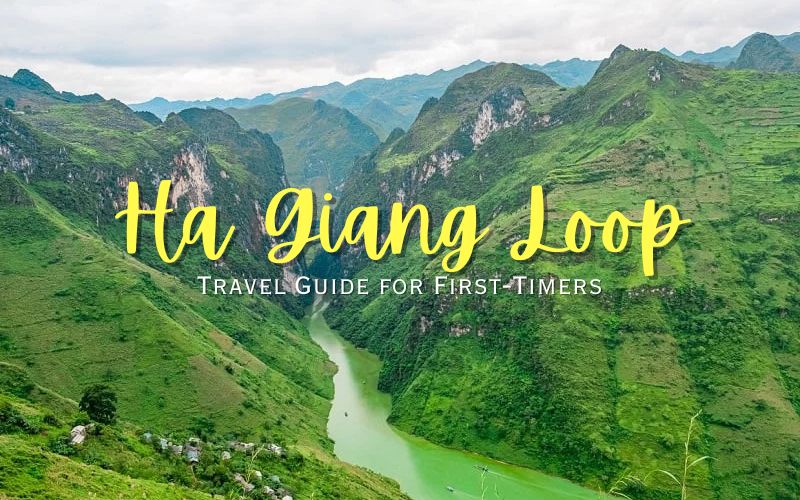
Have you ever heard of Ha Giang Loop, the most beautiful winding road arch in Vietnam? Or are you going to leave the city centre and turn to spectacular rocky mountains and minority villages hidden in fog? If your answer is yes, then this blog is all you need for a well-rounded trip to Ha Giang Loop. From how to travel, the best time, and helpful tips, this blog provides insights for a complete experience safely on this challenging road.
We will not say this is an easy journey, but if you are looking for absolute freedom, eye-opening natural landscapes, and heart-pounding moments, then Ha Giang Loop is truly your pick!
What is the Ha Giang Loop?
Ha Giang Loop is an arc-shaped road (loop) about 350 – 400 km long, located in the far north of Vietnam. There is rough terrain, overlapping mountain hills, and the population is mainly ethnic minorities such as H’mong, Dao, Tai, and Lo Lo… This is a journey in which you ride a bike across winding paths, through remote villages, through sharp cliff mountains, and through valleys that open up unexpectedly like paintings.
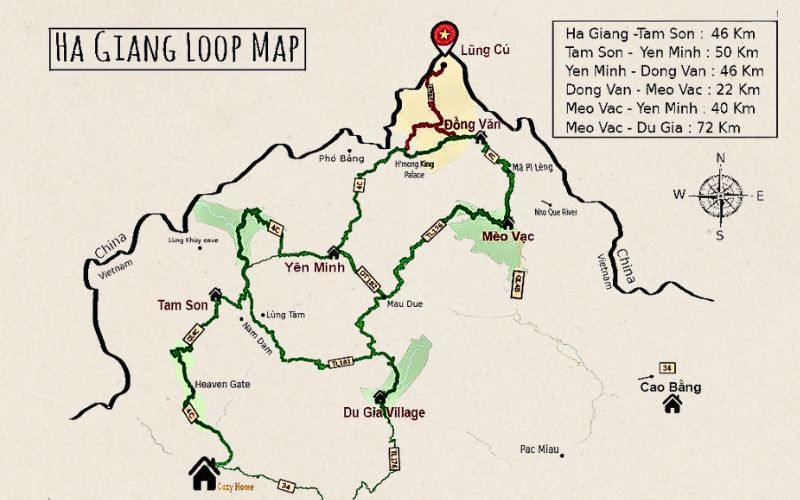
Ha Giang Loop Map
The most popular route usually departs from the city of Ha Giang, in the direction of Quan Ba – Yen Minh – Dong Van – Meo Vac – Du Gia, and back to Ha Giang. Depending on the time you have, the supply can be shortened to 3 days or last 4-5 days to go slower and feel more.
You can ride your own bike if you have an international driver’s licence and are good at riding. Or else, you can choose “easy driver”; it means you sit behind the car driven by a local driver. This is a very popular option with foreign tourists who want to enjoy the scenery without worrying about driving.
In short, what makes Ha Giang Loop different is the feeling of going out of the comfort zone, going on an “off the beaten route” and enjoying every moment amidst majestic nature and honest people.
When is the Best Time to Do the Ha Giang Loop?
The good news is that you can go to Ha Giang Loop almost all year round, because each season here has its own beauty. But if you ask when the most “peak” time to conquer this legendary place, the answer is from October to April. It’s dry, rainy, neither too hot nor too cold, and ideal for long-distance bike trips across dangerous mountain trails.
In particular, if you arrive between late October and early December, you will be able to admire the triangular flowering season that blooms throughout the mountain slopes and the terrace fields. The whole rocky plateau is like a jacket on a soft pink-purple sheet, causing anyone who first sets foot to shout out, “So breathtakingly beautiful!” This is the time that many photographers and backpackers look forward to the most in the year.
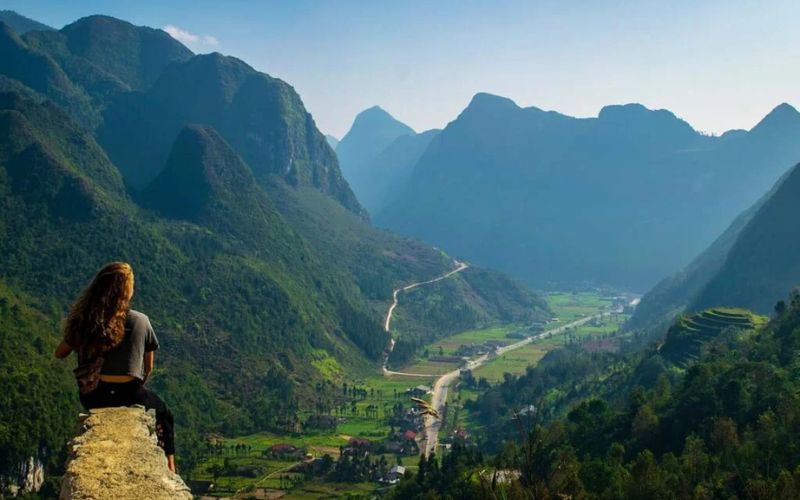
Magnificent landscapes in Ha Giang Loop
From January to March, Ha Giang enters spring. The air is now somewhat cold, but compensated by the landscape of peaches, plums, and cauliflower blooming throughout the villages. You will see Mong children wearing floral skirts running around the fields, and smoke rising from the roofs of houses.
In contrast, from May to September is the rainy season. If you are not used to driving on wet, slippery mountain roads or dense fog, then this is not the ideal time. However, if you choose to go in late May or early June, you will encounter the rainy season, the time when people bring water onto the staircase field to start a new affair. I went to Ha Giang this time once, and the scene is very unique: each step of the field is shining silver, reflecting the clouds, creating an unforgettable setting.
A small note: Avoid going during Lunar New Year or major holidays in Vietnam if you do not want to encounter “no rooms available” and crowded stops. Regardless of the season, you should bring a light jacket, because early mornings and nights in Ha Giang are often colder than expected. In addition, the weather in the mountains changes very quickly, therefore, always be ready with a light raincoat, waterproof bags for your belongings and remember to check your motorbike carefully before each trip.
>>> Have you ever seen a picture of mountainous areas Vietnam covered with white plum flowers or buckwheat flower especially in Ha Giang? Visit this blog for more information about flower seasons in Vietnam.
How to Choose Between Riding Yourself or Hiring a Guide?
Most first-timers to Ha Giang Loop ask us, “Should I drive myself or hire a local rider?” The answer is not simple because it depends a lot on your experience, preferences and ability to “risk”.
If you are the type of person who loves freedom, has an international motorbike driving licence and has ridden on steep mountain passes, then driving yourself will definitely be an unforgettable experience. The feeling of mastering the steering wheel, conquering every “sharp” bend, stopping wherever you want to breathe in the mountain air, or capturing a spectacular scene all make the journey very “unique”.
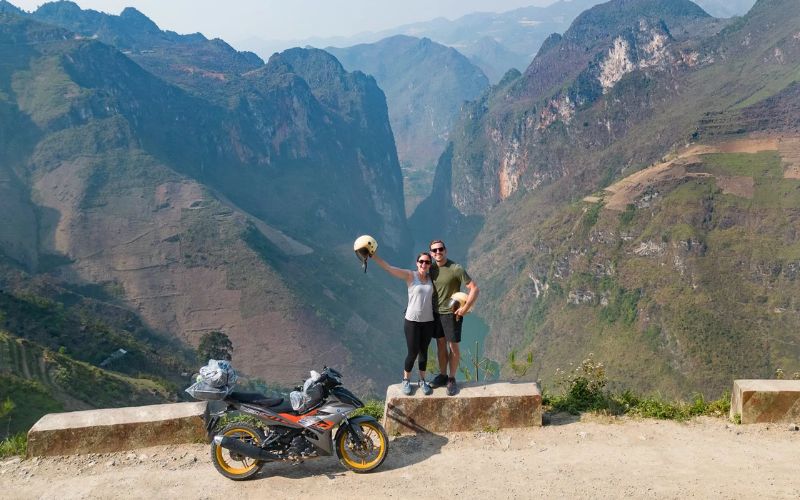
A couple of motorbike ride motorbike check-in Ha Giang Loop
However, you should remember that: Ha Giang is not an easy road. Some sections, like Ma Pi Leng Pass or Tham Ma Slope, are both narrow and steep, with trucks coming from the opposite direction, which will be a real challenge if you are not confident.
And if you’ve never driven a trail before or just want to enjoy the scenery without worrying about technology, maps or dangers, then hiring a native “easy rider” is a much safer and more fun option. They are not only good at driving but also know the beautiful stops few people know, understand the local culture and can help you connect with the natives more easily. Sitting in the back of the car, putting everything on for the guide, you just let go of the floating clouds and mountains.
Top Highlights along the Ha Giang Loop
Streching over 350 km through rugged mountain passes and majestic rocky plateaus, the Ha Giang Loop is a challenging but extremely rewarding journey. With breathtaking natural scenery, unique ethnic culture and once-in-a-life-time stops, this journey makes anyone who has ever been there want to come back again. Here are the highlights not to be missed on this route.
Ma Pi Leng Pass – The legendary pass in the clouds
Located between Dong Van and Meo Vac towns, Ma Pi Leng Pass is one of the “four great mountain passes” in northern Vietnam. The pass is about 20 km long, hugging the steep mountainside, with a steep cliff on one side and a deep abyss on the other where the Nho Que River winds like a green silk strip. This is a classic check-in point for all backpackers when coming to Ha Giang.
From stops such as Ma Pi Leng Pass Viewpoint or Panorama Coffee, visitors can enjoy a panoramic view of the river valley below – a scene that is both majestic and strangely peaceful. I still remember vividly the first time I stood on the top of the pass, I was really silent for a long time. The sun was starting to set, casting its last golden light on the rocky mountains, and below, the Nho Que River sparkled like a mirror. Honestly, I have never seen anything so beautiful.
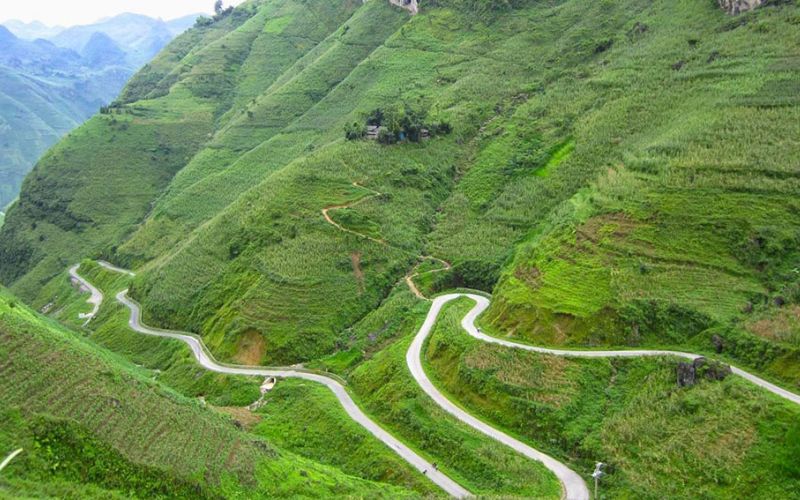
Ma Pi Leng Pass
Nho Que River and Tu San Gorge – A green gem in the middle of grey rocks
Hidden at the foot of Ma Pi Leng Pass is the Nho Que River. The river is renowned for its characteristic emerald green water color, winding through Tu San Gorge, considered the deepest gorge in Southeast Asia.
Visitors can take a motorboat or kayak through this section of the river, experiencing the feeling of being “lost” between two vertical cliffs hundreds of meters high. The scenery here has a surreal beauty, wild and peaceful, making anyone want too stop for a long time.
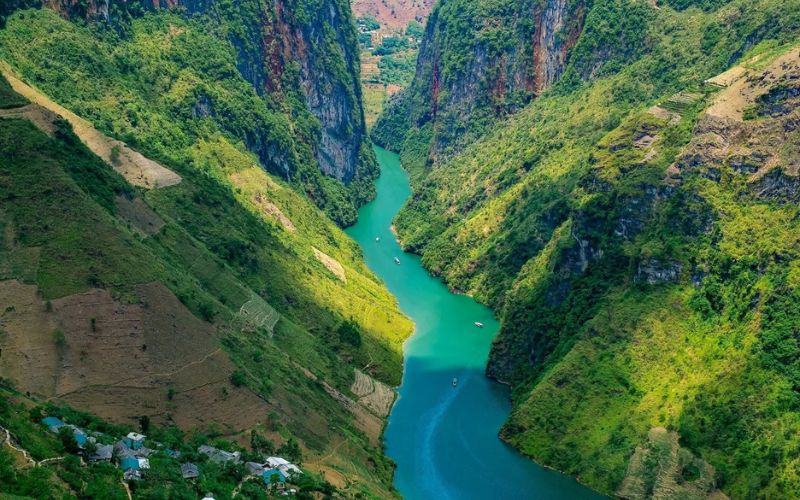
Nho Que River and Tu San Gorge
Dong Van Old Town – A gentle silence in the mountains and forests
As the administrative centre of Dong Van district, this ancient town stands out with its dark yellow brick houses and yin-yang tiled roofs and ancient Chinese-influenced architecture. Although small and simple, the Dong Van Old Town still has a strange attraction, especially at night. There are ancient cafes, a night market on weekends, and the typical cool air of the mountain region that makes everything slow and intimate.
Sarah, one of our customers, shared her experience: when sitting in a cafe on the second floor, she can look down at the quiet stone-paved street below. And she felt the wind blow gently; the sound of a guitar came from a group of other foreign guests sitting on the porch. She said in that moment, Ha Giang was no longer majestic but became very romantic.
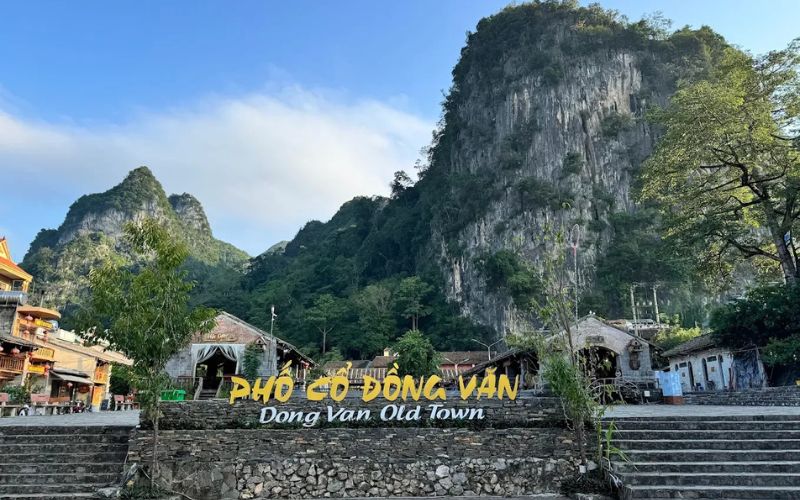
Dong Van Old Town
Vuong Family Mansion – A silent relic in the middle of a rocky valley
About 15 km from Dong Van centre is the Vuong family mansion, the residence of “King Meo” Vuong Chi Sinh, a famous H’Mong leader in the early 20th century. The building has a unique architecture, a blend of H’mong, Chinese and French styles, with stone walls, ancient tiled roofs and elaborate carvings. The mansion is located in a rather isolated valley, surrounded by pine forests and rocky mountains, creating an atmosphere that is both quiet and mysterious.
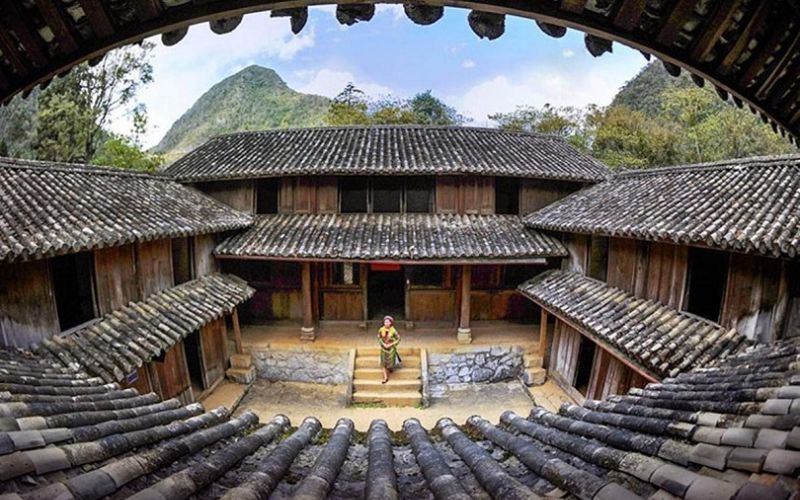
Vuong Family Mansion
Lung Cu Flag Tower – The sacred northernmost part of Vietnam
Lung Cu is the northernmost point of Vietnam, with a yellow star and red flag flying over the top of Dragon Mountain. To reach the top of the flagpole, visitors must climb more than 800 stone steps, a small journey but bringing great emotions.
From the top of the flagpole, you can see Lo Lo Chai village below, a peaceful, small village with brick houses, ancient wells, and friendly people. Many visitors climbed each step and panted as they went, but when they reached the top, seeing the big flag fluttering in the wind, they said they forgot all the fatigue immediately. It was a very strange feeling, proud and peaceful.
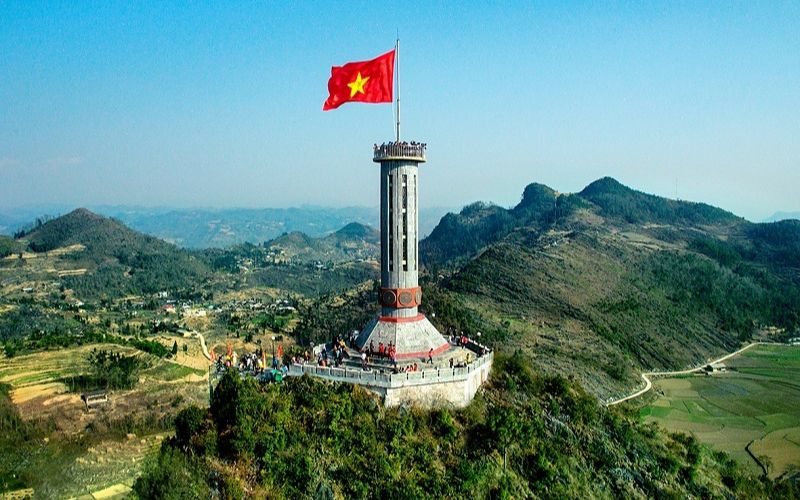
Lung Cu Flag Tower
Highland markets – Where culture truly “lives”
Markets such as Dong Van (opens on Sunday), Meo Vac (opens on Sunday), Sa Phin, etc., are not only places for trading but also cultural spaces typical of the highlands. On the opening day, people from remote villages flock to the market, bringing agricultural products, livestock, fabrics, and even stories!
The colours of traditional costumes, laughter, trumpet sounds, and the smell of thang co and corn wine blend together to create a lively, pristine atmosphere that cannot be found anywhere else. Sitting with a group of Dao people, although you don’t speak their language, you still understand them. No one said much, just laughed and offered each other a drink. No language needed, but still each other by living very honestly.
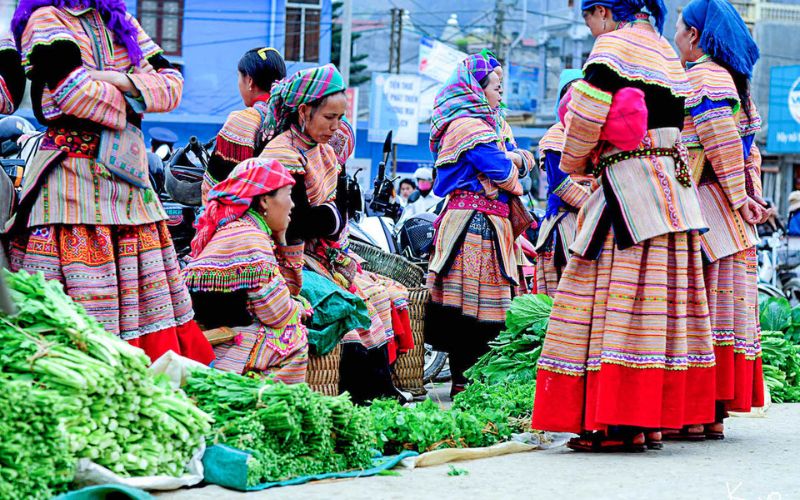
Dong Van Market
Ethnic minority villages – The indigenous soul of Ha Giang
Nowhere in Vietnam is cultural diversity as evident as in Ha Giang. On the same route, you can meet the H’Mong people on the mountain slopes, the Red Dao people in the valleys, the Black Lo Lo people with colourful costumes by the fire, or the Tay people living near cool streams. Small villages nestled between rocks or nestled next to terraced fields are not only places to live but also places that preserve the original spirit of the highlands.
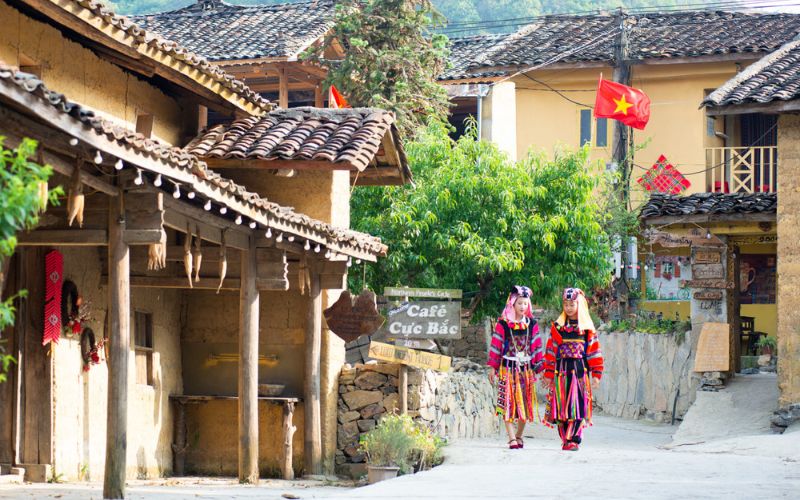
Lo Lo Chai village
Here are some typical villages that tourists should visit:
- Lo Lo Chai village (near Lung Cu flag tower): peaceful, pristine, and famous for its rammed earth architecture and traditional, closed lifestyle.
- Tha village (Phuong Do ward, Ha Giang City): Tay village with stilt houses in the middle of rice fields, a peaceful atmosphere and hospitable people.
- Sung La village (Dong Van district): This village was used to be the filming location for the movie “Pao’s Story”, famous for ít buckwheat flower season and ancient rammed earth roofs.
- Pa Vi Ha Village (Meo Vac): H’Mong people live in large numbers, with developed homestay services and easy exchange of indigenous culture.
- Nam Dam Village (Quan Ba): Dao people’s habitat, outstanding with ecological space, an ideal place to experience community tourism.
In particular, many villages have now developed community tourism in a sustainable direction. Visitors can stay in traditional homestays, participate in cooking with the host family, make corn cakes, spin flax, weave fabric, or go to work in the fields, collect wild herbs…
>>> If you love exploring culture and want to interact with ethnic mirorities people in northern part of Vietnam, reach out to our Amazing 8 Days Northeast Vietnam Tour. Depart from Hanoi, this tour brings you to Ha Giang, Cao Bang and Ba Be, which are hidden gems of northern mountainous area of Vietnam.
What to Pack for the Ha Giang Loop?
Ha Giang Loop is a long day’s journey. Through the steep mountainous terrain, the weather can change rapidly in just a few hours. Therefore, to ensure your safe and smooth experience, it is very important to prepare your luggage properly. The following is a list of things that should be carried, suitable for the climatic conditions and material basis of the highlands.
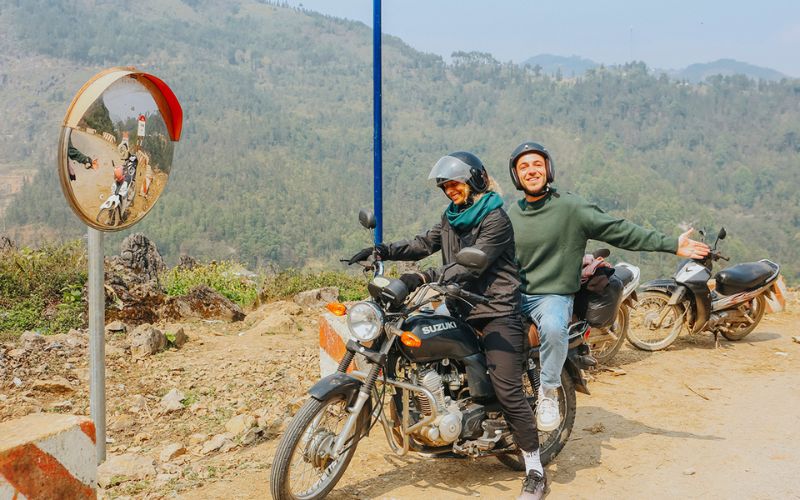
Visitors conquer Ha Giang Loop by motorbike
- Clothing suitable for weather and terrain: Ha Giang has a mountainous climate, cold in the mornings and nights, then has plenty of sunshine at noon, and fog may suddenly appear, especially in winter or the rainy season. Even in summer, you should take a windbreaker or a light coat, quick-drying T-shirts, gloves, and stockings should also be in your luggage. Your clothes should be neat, convenient, easy to clean, and easy to change when the weather changes.
- Protective equipment for motorcycle driving: The Ha Giang Loop is mainly driven by motorcycles, so protective equipment is essential. A good helmet with a windscreen is mandatory. Sunscreen gloves, dust-proof and insect-proof sunglasses, and compact raincoats are necessary to cope with the sudden rainstorm. If you rent a motorcycle in Ha Giang, please ask about the accessories carefully or prepare them separately to ensure safety.
- Footwear: Lightweight sneakers or trekking shoes with good grip are the ideal choice for moving on stretches of mountain, rocky, or flat terrain. In addition, it is recommended to bring a pair of sandals or slippers for use in the homestay or when bathing or taking an evening break.
- Personal items: Travelling to the highlands does not always have the same amenities as in the city. Visitors should bring along personal items such as face towels, toothbrushes, toothpaste, dry soap, wet tissues, sunscreen and mosquito repellent. In addition, you should have a personal water bottle (refillable) or a small thermos to carry drinking water when travelling.
- Basic medical supplies: You should prepare a small medicine bag including cold medicine, digestive medicine, anti-allergy medicine, pain reliever, bandage, balm, and motion sickness medicine. In some remote areas, pharmacies are not available or are only open during business hours, so it is necessary to proactively bring medicine.
- Electronics and utilities: For photography, navigation, and communication, travellers should bring a spare charger, a power adapter (if needed), a flashlight or headlamp, and extra memory cards for the camera. An offline map app like Google Maps (with pre-loaded maps) or Maps.me is useful when there is no internet connection.
- Documents and cash: Ha Giang does not have many ATMs, and most homestays or small restaurants do not accept card payments. Visitors should prepare enough cash for the entire trip. In addition, you should bring your passport, an international driving licence (if you drive on your own), and a photocopy of your ID in case of need.
- Small tips: Do not bring too many things. The ideal luggage for the Ha Giang loop should be packed in a medium-sized backpack, easy to tie to the back of a motorbike or carry on your back when moving. Minimalism and convenience are the keys to a comfortable and safe trip.
>>> Check out Ha Giang Tours for unforgettable region’s hidden cultural charms exploration which is catered for every stage of your journey, ensuring smooth experience.
Where to Stay During Your Ha Giang Loop Trip?
Ha Giang Loop has many stops, each with accommodation options to suit different budgets and travel styles. From rustic ethnic stilt houses to comfortable hostels for international backpackers, you will always find a suitable place to rest on your journey. Here are some suggested places for you to refer to:
Ha Giang City – Starting point and preparation
Before starting the journey, most tourists choose to stay 1 night in Ha Giang city to pick up their motorcycles, arrange their luggage, and rest. You can note down these places to stay based on Ha Giang Loop route:
- Ha Giang hostel: Famous in the international backpacker community. They provide clean dorm rooms, motorbike rental service and route support.
- NoMadders Ha Giang: This is a modern-style hostel serving breakfast, suitable for groups of friends.
Ha Giang Riverside Hostel: This place has river views and is close to the centre.
Yen Minh – A stop on the middle of the pine forest
Yen Minh is usually the first night stop if you follow the 3-4 day itinerary. There are two places you can choose to stay:
- Yen Minh Eco Lodge: A small wooden house in the middle of the pine forest with warm rooms that serve family meals.
- Bong Hostel: This hostel is popular with backpackers, with dorm rooms and private rooms overlooking the town.
Dong Van – The heart of the rocky plateau
Dong Van is the main accommodation of the route, with many homestays and guesthouses near the old town:
- Dong Van B&B: A renovated ancient house near Ha Giang night market.
- Homie Homestay: A traditional rammed earth house, serving local food.
- Hoang Ngoc Hotel: Suitable for those who need a more comfortable room.
Meo Vac – The other side of Ma Pi Leng Pass
Meo Vac is an ideal resting place after conquering Ma Pi Leng Pass. You can rest at:
- Little Yen Homestay: Wooden house located halfway up the mountain, panoramic view of the valley.
- Meo Vac Clay House: A Traditional rammed earth house, quiet space.
- Auberge de Meo Vac: Boutique-style accommodation, good service.
Du Gia – A peaceful village in the middle of the mountain
Du Gia is the last stop before returning to Ha Giang city. This place is famous for waterfalls and a relaxing atmosphere.
- Du Gia Panorama: View of the terraced fields valley, delicious family meals.
- Du Gia Backpacker Hostel: Vibrant atmosphere, suitable for groups of young people.
- Du Gia Homestay: Tay people’s wooden stilt house, experience sleeping on thick cotton blankets and listening to the sound of the stream flowing.
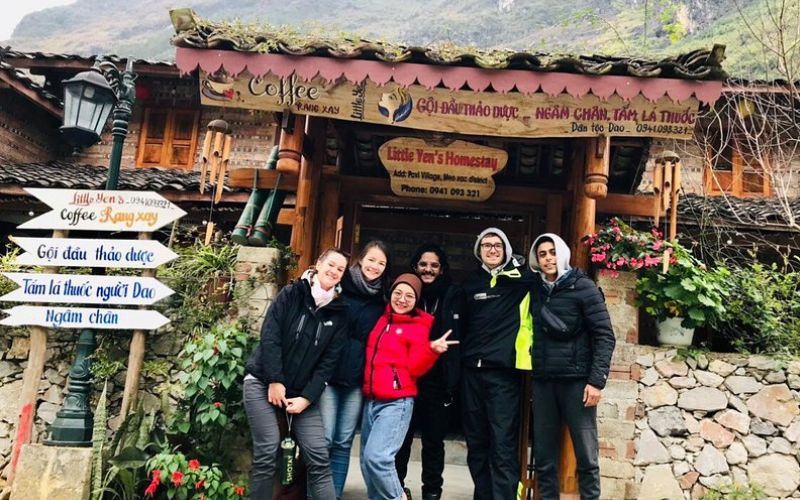
Little Yen Homestay, Meo Vac, Ha Giang
How Much Will It Cost for 3-4 Days in Ha Giang Loop?
The cost of a 3-4 day trip to the Ha Giang Loop depends on how you choose to experience it. Here is the estimated cost for a 3-4 day trip:
Motorcycle rental or easy rider service
- Self-driving motorcycle rental: 200,000 – 300,000 VND/day ($8 – $12), not including petrol.
- Easy rider (sitting behind the local driver’s car): 600,000 – 1,000,000 VND/day ($25 -$40), including petrol and driver’s license.
Gastroline
If you run an average of 80 – 120 km per day, gasoline costs might be about 80,000 – 120,000 VND/day ($3 – $5).
Accommodation
- Traditional homestay: 150,000 – 250,000 VND/night ($6 – $10), usually including breakfast.
- Hostel/Guesthouse more convenient: 250,000 – 400,000 VND/night ($10 – $16)
Eating and drinking
- Homestay main meal: 100,000 – 150,000 VND/person ($4 – $6), usually with the host family.
- Local restaurant: 50,000 – 100,000 VND/meal ($2 – $4).
Entrance tickets
Places such as Vuong Palace, Lung Cu Flag Tower, Ma Pi Leng are have entrance tickets of about 10,000 – 30,000 VND ($0.5 – $1.5).
Additional expenses
- Drinks, coffee, snacks: 50,000 – 100,000 VND ($2 – $4)
- Souvenirs or brocade: Depending on your needs.
To sum up, the estimated budget for a 3-4 day trip to Ha Giang Loop will depend on your kind of travel. If you conquer the loop by self-driving, the cost will be around 2,000,000 – 3,000,000 VND ($80 – $120) for the entire trip. Meanwhile, it is higher if you travel with an easy rider, at about 4,000,000 – 6,000,000 VND ($160 – $240) for the entire trip. However, remember this is only our suggested budget; the real cost is variable, depending on other factors.
Helpful Tips for First-Timers to Ha Giang Loop
Conquering the Ha Giang Loop is a special experience and sometimes a big challenge, especially for those who are visiting the northern highlands of Vietnam for the first time. Here are some practical tips to make your trip safer, smoother, and more memorable.
Only drive yourself if you are really confident: Driving a motorbike yourself is a popular choice, but not for everyone. The Ha Giang pass is narrow and steep, with many hairpin turns, sometimes with fog and oncoming trucks. Therefore, you should only drive yourself if you have a valid international driving licence and are familiar with the pass. If you are not confident in driving, the easy rider service is a safer option while still maintaining the full experience.
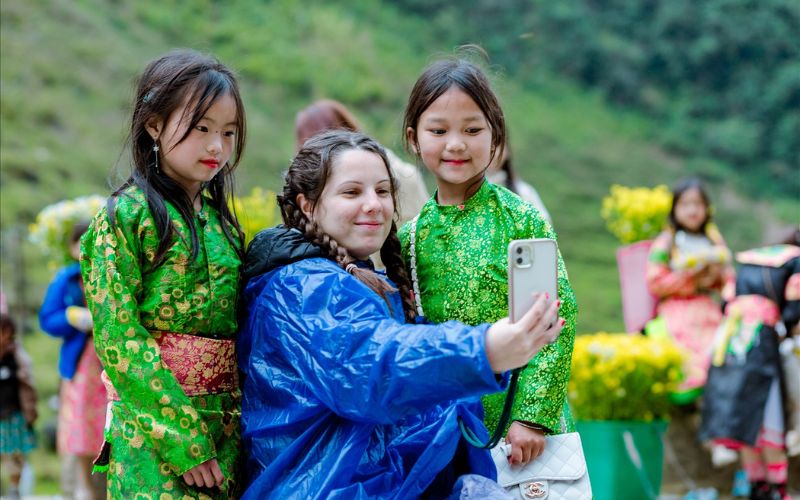
Tourist takes picture with ethnic minority children in Ha Giang
- Choose a tour with a reasonable itinerary: If you go on a tour, you should carefully research the itinerary, travel time each day and type of accommodation. Some tours run so fast that there is not enough time to stop and explore. The duration of 3-4 days is the most popular and reasonable for beginners, allowing them to fully experience the main points such as Dong Van, Ma Pi Leng, Meo Vac and Du Gia.
- Always fill up your tank before leaving town: On the Ha Giang Loop, there are many stretches of road stretching for tens of kilometres without gas stations. Travellers should fill up their tanks when passing through major towns such as Yen Minh, Dong Van, and Meo Vac. In addition, you can bring a small spare bottle of gastroline (500 ml – 1 L), especially if you travel during the low season.
- Avoid driving at night: At night in the mountains, it is very dark, there are no street lights, there is thick fog, and the temperature drops sharply. Most accidents occur due to driving late or trying to “drive a few more metres/kilometres”. You should finish your journey each day before 5:00 pm to ensure safety and have time to rest.
- Respect local culture: Ha Giang is home to many ethnic minorities; each community has different customs and lifestyles. Visitors should dress politely, ask for permission before taking photos of local people, and limit noise when entering villages. Avoid public intimacy or showing disrespect for local customs.
- Prepare cash and a local SIM card: Many homestays, restaurants, and services in remote areas do not accept electronic payments. You should bring enough cash for the entire trip. Vietnamese SIM cards (Viettel or Vinaphone) have more stable signals in mountainous areas; therefore, you should buy them in Hanoi and pre-load 3G/4G data to use maps and communicate.
- Check the weather every morning: Ha Giang’s weather changes rapidly, especially during the rainy or winter season. Before starting your journey each day, check the weather to decide what to wear and whether to change your itinerary or stay overnight to ensure safety.
- Go slowly, and enjoy more: There is no need to be like a race. Ha Giang is not a place to conquer quickly but to feel. Every corner, every village, every face of the people here bears a distinct trait that deserves to be stopped and observed more closely. Don’t be in a hurry, sometimes the best thing is the moment you slow down.
Ha Giang Loop is more than just a motorcycle route; it’s a journey of maturity, an encounter with pristine nature, and a chance to live slowly, truly amidst rocky mountain skies. From the climbing trails to the Mongol villages hidden in the early fog, every kilometre is an experience both overwhelming and profound. You will cope with many difficulties, but in return, you’ll have moments that aren’t found in any upscale tour. This journey is not about checking in but about feeling with all your senses and heart.
So, does this blog inspire your wish for freedom? Don’t hesitate to contact us for your adventure to Ha Giang Loop, and let your feet pass through the majestic landscape of the northeast mountainous areas of Vietnam!
Read more:
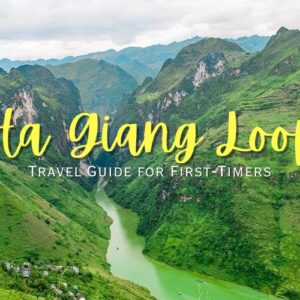
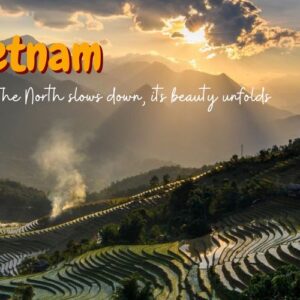


Should we rent a motorbike to explore on our own, or hire a driver as well? There are just two of us.
That really depends on your confidence and experience. If you’re both comfortable on motorbikes, renting one and riding the Loop yourselves is the ultimate adventure, you’ll have the freedom to stop anywhere and soak in the views. But keep in mind, the roads can be challenging with sharp turns, steep climbs, and unpredictable weather.
If you’re not 100% confident, I’d suggest hiring a local driver (an “easy rider”). You still get the thrill of the journey without worrying about the road conditions, and you’ll also gain local insights along the way. With just the two of you, either option works—just choose the one that lets you enjoy the ride with peace of mind.